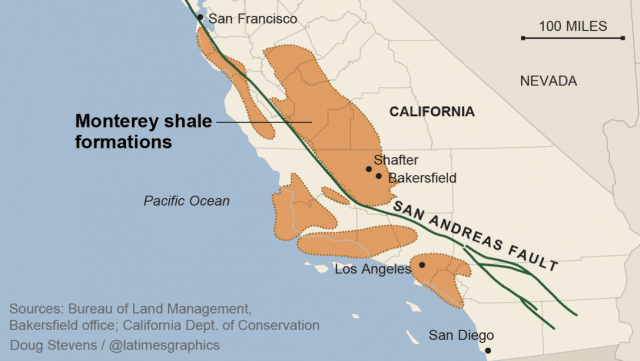Last year, a post here on DeSmog asked: “Could California’s Shale Oil Boom Be Just a Mirage?”
For now, the answer appears to be a resounding yes.
According to the LA Times, the US Energy Information Administration (EIA) is set to announce next month that it is officially downgrading its estimate of the oil reserves in California’s Monterey Shale from 13.7 billion barrels to 600 million barrels — a 96% decrease.
Modern technology, it seems, is just not up to the task. The EIA will issue its new estimate after reviewing output from oil operations using the latest technologies like fracking and acidization, which eats away rock.
“From the information we’ve been able to gather, we’ve not seen evidence that oil extraction in this area is very productive using techniques like fracking,” said John Staub, a petroleum exploration and production analyst with the EIA, according to the LA Times.
At one point, the Monterey Shale was expected to fuel a new “black gold rush” in the Golden State. Initial estimates in 2011 put the amount of recoverable oil from the Monterey Shale at 15.4 billion barrels. The EIA revised this number down to 13.7 billion in 2012, which was still some two-thirds of shale reserves in the entire US.
As the LA Times notes, “The estimate touched off a speculation boom among oil companies. The new findings seem certain to dampen that enthusiasm.”
Environmentalists reacted to news of the downgrade with some relief but little surprise.
“The oil had always been a statistical fantasy,” says geoscientist J. David Hughes of the Post Carbon Institute, who published a report last December that was critical of the EIA estimates. Hughes’ findings were based on an analysis of actual oil production data from the Monterey Shale, which drastically underperformed the industry’s projections.
While several of the major oil companies have been wary all along, not everyone is giving up so easily. It’s not that the oil isn’t there, it’s just that the Monterey Shale’s unique geography presents challenges for which existing methods have no answer, and there may yet be a technological innovation that will allow the exploitation of the Monterey Shale’s reserves.
“As the technologies change, the production rates could also change dramatically,” Tupper Hull, a spokesman for the Western States Petroleum Assn., told the LA Times.
Subscribe to our newsletter
Stay up to date with DeSmog news and alerts






